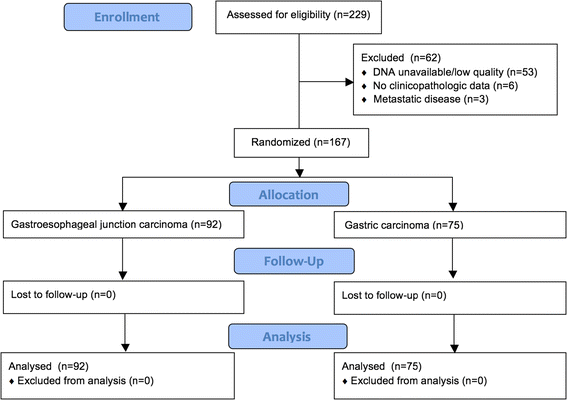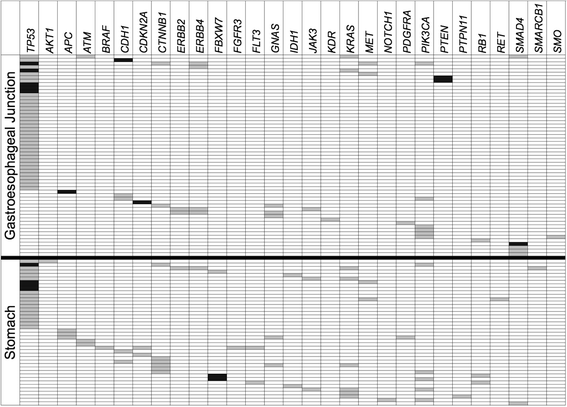Retrospective review using targeted deep sequencing reveals mutational differences between gastroesophageal junction and gastric carcinomas
- PMID: 25656989
- PMCID: PMC4322811
- DOI: 10.1186/s12885-015-1021-7
Retrospective review using targeted deep sequencing reveals mutational differences between gastroesophageal junction and gastric carcinomas
Abstract
Background: Adenocarcinomas of both the gastroesophageal junction and stomach are molecularly complex, but differ with respect to epidemiology, etiology and survival. There are few data directly comparing the frequencies of single nucleotide mutations in cancer-related genes between the two sites. Sequencing of targeted gene panels may be useful in uncovering multiple genomic aberrations using a single test.
Methods: DNA from 92 gastroesophageal junction and 75 gastric adenocarcinoma resection specimens was extracted from formalin-fixed paraffin-embedded tissue. Targeted deep sequencing of 46 cancer-related genes was performed through emulsion PCR followed by semiconductor-based sequencing. Gastroesophageal junction and gastric carcinomas were contrasted with respect to mutational profiles, immunohistochemistry and in situ hybridization, as well as corresponding clinicopathologic data.
Results: Gastroesophageal junction carcinomas were associated with younger age, more frequent intestinal-type histology, more frequent p53 overexpression, and worse disease-free survival on multivariable analysis. Among all cases, 145 mutations were detected in 31 genes. TP53 mutations were the most common abnormality detected, and were more common in gastroesophageal junction carcinomas (42% vs. 27%, p = 0.036). Mutations in the Wnt pathway components APC and CTNNB1 were more common among gastric carcinomas (16% vs. 3%, p = 0.006), and gastric carcinomas were more likely to have ≥3 driver mutations detected (11% vs. 2%, p = 0.044). Twenty percent of cases had potentially actionable mutations identified. R132H and R132C missense mutations in the IDH1 gene were observed, and are the first reported mutations of their kind in gastric carcinoma.
Conclusions: Panel sequencing of routine pathology material can yield mutational information on several driver genes, including some for which targeted therapies are available. Differing rates of mutations and clinicopathologic differences support a distinction between adenocarcinomas that arise in the gastroesophageal junction and those that arise in the stomach proper.
Figures





References
Publication types
MeSH terms
Grants and funding
LinkOut - more resources
Full Text Sources
Other Literature Sources
Medical
Research Materials
Miscellaneous

